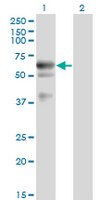ST1603 Anti-LIPG Mouse mAb (1E11)
Recommended Products
Overview
| Replacement Information |
|---|
Key Spec Table
| Host |
|---|
| M |
| References |
|---|
| Product Information | |
|---|---|
| Form | Liquid |
| Formulation | In PBS, pH 7.2. |
| Preservative | None |
| Biological Information | |
|---|---|
| Immunogen | Full-length, recombinant human LIPG (aa 21-501), expressed as a GST fusion protein |
| Clone | 1E11 |
| Host | Mouse |
| Isotype | IgG2a |
| Physicochemical Information |
|---|
| Dimensions |
|---|
| Materials Information |
|---|
| Toxicological Information |
|---|
| Safety Information according to GHS |
|---|
| Safety Information |
|---|
| Product Usage Statements |
|---|
| Packaging Information |
|---|
| Transport Information |
|---|
| Supplemental Information |
|---|
| Specifications |
|---|
| Global Trade Item Number | |
|---|---|
| Catalogue Number | GTIN |
| ST1603 | 0 |








